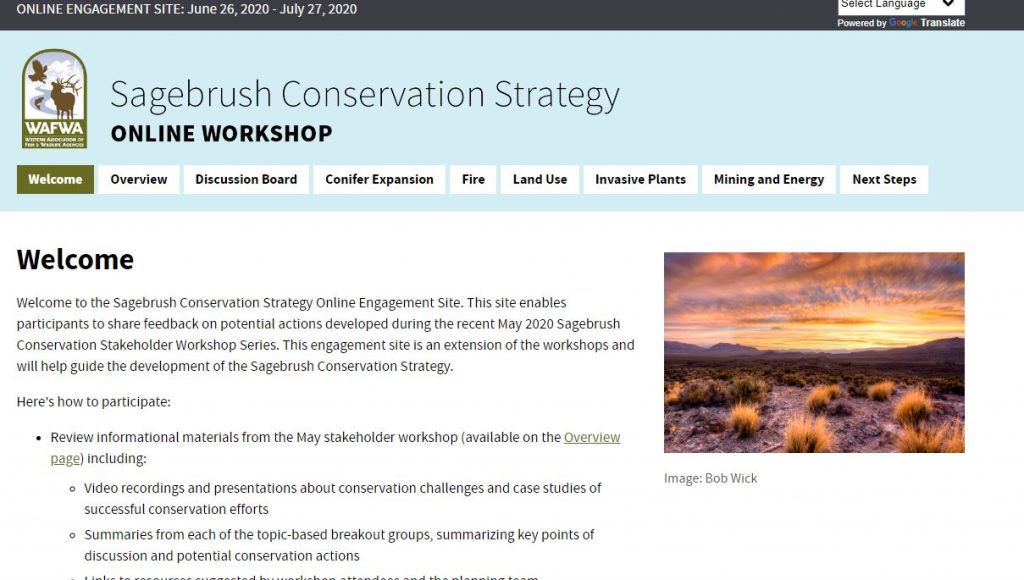WAFWA Seeks Input on Strategies to Conserve the Sagebrush Country
The Western Association of Fish and Wildlife Agencies (WAFWA), with its conservation partners, invites those living, working or invested in the sagebrush ecosystem to participate in an online, on-demand workshop through July 27. Organizers goals are to identify innovative, voluntary and collaborative strategies that address sagebrush conservation challenges.
Sagebrush, a pungent, woody shrub found in arid areas of the western United States, is the namesake of an extremely endangered ecosystem. Sagebrush landscapes are home to more than 350 species of wildlife, some of which are completely dependent on sagebrush for food and cover. Before settlement, sagebrush likely occurred on over 96 million acres across 13 states and 3 Canadian Provinces. The current distribution is about 60 million acres and much of what remains has been impacted by invasive plants or human infrastructure. The loss and degradation of areas formerly dominated by sagebrush has contributed to declines in wildlife that depends on sagebrush, including iconic western species such as mule deer, and other species which have been petitioned for listing under the Endangered Species Act in the past such as greater sage-grouse and pygmy rabbits.

The Sagebrush Executive Oversight Committee (Sagebrush EOC), comprised of leaders of Federal Land Management and Natural Resource Agencies and State Wildlife Agencies, was formed to coordinate conservation activities for sagebrush. The Sagebrush Conservation Strategy is being developed under the direction of the Sagebrush EOC to provide a guidance document for the management of sagebrush landscapes. A critical component of this Strategy is input from stakeholders on conservation actions that address challenges to the ecosystem and that would be actively supported in local areas across the landscape.
The online workshop (https://sagebrushconservationworkshop.participate.online/) extends a series of virtual workshops convened in May, where over 100 stakeholders developed promising, potential actions to address sagebrush conservation challenges across the West. During the virtual workshops, scientists, landowners, land managers, industry leaders, communicators, and community members focused on conservation challenges related to wildfire, invasive weeds, land use, conifer expansion and mining and energy through informational presentations and breakout work sessions. The current online workshop offers an opportunity to solicit additional feedback on actions identified during the May workshops, and invites the public to offer other conservation actions to be considered for inclusion in the final strategy.
You can participate in identifying approaches to conservation of sagebrush by clicking on the link (https://sagebrushconservationworkshop.participate.online/) and evaluating proposed actions or identifying new ones. The site will be open from June 30 through July 27th. “Sagebrush conservation requires essential partnerships. We believe engaging sagebrush community members who are closest to the problem will lead to successful, barrier-busting approaches.” – Tony Wasley, Director of Nevada Department of Wildlife. For more information on the online workshop, or the development of the Sagebrush Conservation Strategy, please contact San Stiver, WAFWA, at san.stiver@wafwa.org.
Since 1922, the Western Association of Fish and Wildlife Agencies (WAFWA) has advanced conservation in western North America. Representing 24 western states and Canadian provinces, WAFWA’s reach encompasses more than 40 percent of North America, including two-thirds of the United States. Drawing on the knowledge of scientists across the West, WAFWA is recognized as the expert source for information and analysis about western wildlife. WAFWA supports sound resource management and building partnerships at all levels to conserve wildlife for the use and benefit of all citizens, now and in the future.
Contact: San Stiver
san.stiver@wafwa.org
Comments (0)